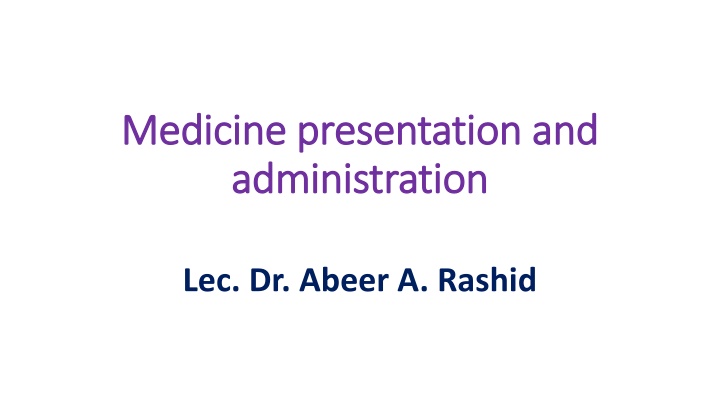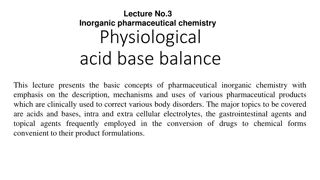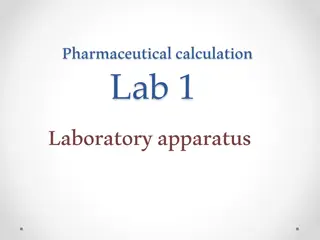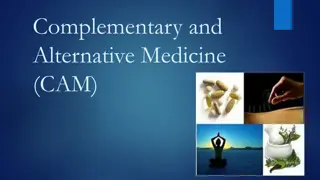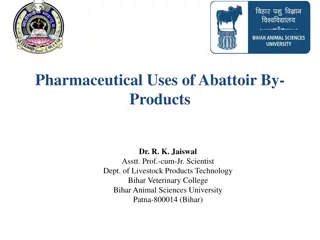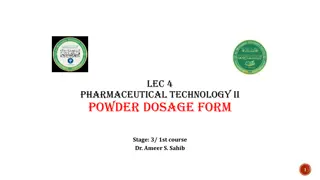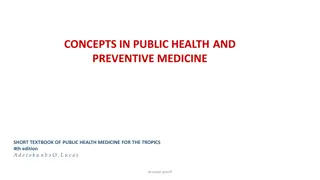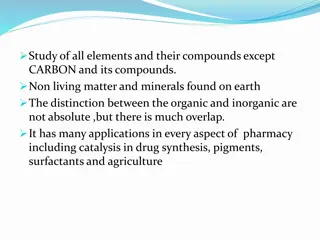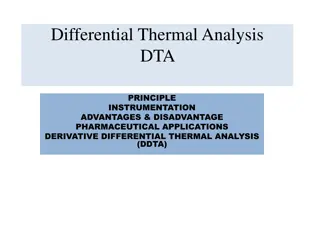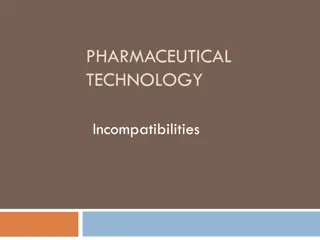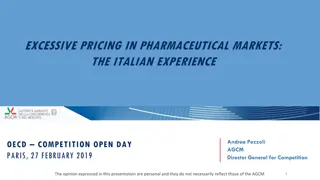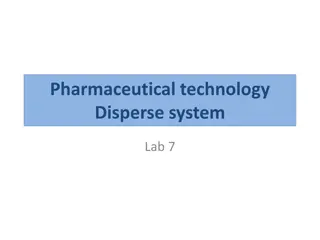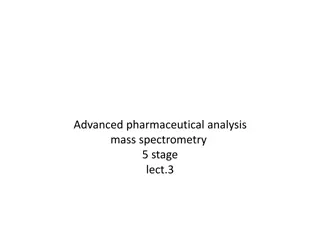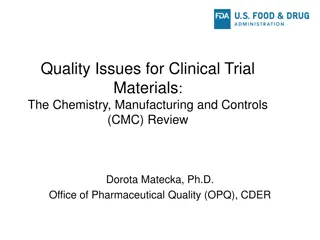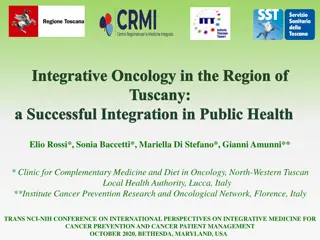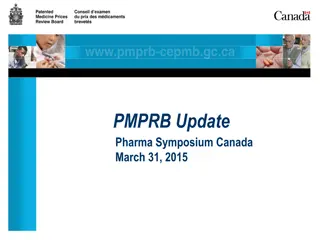Fundamentals of Pharmaceutical Development and Medicine Administration
Understanding the definition of medicinal products, drug actions, and formulation development processes is crucial for efficient medicine administration. Proper adherence to medication rights ensures safe and effective treatment delivery, emphasizing the importance of dosage form development through pre-formulation and formulation studies.
Download Presentation

Please find below an Image/Link to download the presentation.
The content on the website is provided AS IS for your information and personal use only. It may not be sold, licensed, or shared on other websites without obtaining consent from the author.If you encounter any issues during the download, it is possible that the publisher has removed the file from their server.
You are allowed to download the files provided on this website for personal or commercial use, subject to the condition that they are used lawfully. All files are the property of their respective owners.
The content on the website is provided AS IS for your information and personal use only. It may not be sold, licensed, or shared on other websites without obtaining consent from the author.
E N D
Presentation Transcript
Medicine presentation and Medicine presentation and administration administration Lec. Dr. Abeer A. Rashid
Definition of a medicinal product Definition of a medicinal product A medicinal product is any product used for the prophylaxis or management of diseases that brings about the purpose of affecting body function or is used to make a medical diagnosis. earlier times, plants were the primary source of substances intended for a medicinal effect. Minerals and substances of animal origin started to be used later on.
As the purity and potency of drugs or active ingredients have increased, the dose required has decreased When introduced into the body, all drugs cause cellular changes, described as drug action, followed by physiological changes that are described as the drug effect
The The rights rights of of medicine administration medicine administration When administering medicines, it is important to ensure that the right medicine at the right dose, in the right form is administered to the right patient, at the right time, by the right route, using the right technique, and that the right documentation is kept.
Pharmaceutical development Pharmaceutical development Drugs have to undergo pre-formulation studies and formulation development to present the drug in an appropriate dosage form. This is a complex, time-consuming and expensive process.
Pre Pre- -formulation studies formulation studies These are carried out to investigate the physical and chemical properties of a drug including: solubility and dissolution rates chemical stability lipophilicity melting point particle morphology.
Formulation development Formulation development Aims to develop formulations of the drug while overcoming shortcomings of the compound (e.g. low solubility in water for omeprazole, taste) Takes into account properties of drug substance and desired final dosage form.
Route of administration Route of administration Drug effects can be subdivided into: systemic effect: drug is distributed throughout the body to cause a general effect (e.g. tablets) local effect: drug is limited to the area of the body where it is administered (e.g. nose drops).
The choice of a particular route of administration of a drug may depend on many factors, including: desired effect (if a fast action is required, intravenous administration is preferred, e.g. in emergency situations) local effect desired to reduce side-effects (e.g. administration of bronchodilators and corticosteroids as inhalers in asthma) absorption qualities of the drug (e.g. administration of gentamicin for a systemic effect has to be done parenterally) the ability of the drug to withstand the conditions of the gastrointestinal tract (e.g. insulin cannot be administered orally since it is degraded in the gastrointestinal tract).
Considerations in dosage form development Considerations in dosage form development Conceal taste and odour for orally administered preparations (e.g. capsules, syrups) Provide protection of drug from destruction in the stomach after oral administration (e.g. enteric-coated tablets) Provide liquid preparations of drugs that are insoluble or unstable in a vehicle (e.g. suspensions) Provide rate-controlled drug action (e.g. modified-release tablets and capsules).
Routes of administration and examples of Routes of administration and examples of dosage forms dosage forms Oral route: solid oral dosage forms (tablets, capsules) liquid oral dosage forms (syrups, suspension) Topical route: transdermal drug delivery inhalation nasal, ophthalmic ear drops creams, ointments, lotions, powders Parenteral route: intramuscular, subcutaneous, intravenous use of pumps, implants Rectal route: enemas, suppositories Vaginal route: pessaries, fluid solutions, creams.
Oral route Advantages Simple, convenient Self-administration possible. Disadvantages Irregular absorption from the gastrointestinal tract (e.g. due to food) Drugs may be destroyed by acid or enzymes in the gastrointestinal tract Limitations when patient is unconscious, vomiting or in pre- /post-operative patients.
Formulations Tablets may be: effervescent enteric coated modified release Capsules are easier to swallow but more costly to produce. They may be: soft capsule: a unit that is formed from one piece and where the processes of filling and formation of the outer unit are carried out in a single operation or hard capsule: consists of two separate components, namely the cap and the body.
Sublingual tablets Drug administered under the tongue (e.g. glyceryl trinitrate) Preferred to achieve rapid action or to bypass drug metabolism. Buccal tablets Drug placed between gum and mucous membranes They are absorbed slowly and may be used for a local effect. Modified-release oral preparations Extended-release preparations: preparations where the release of drug is extended to achieve sustained plasma drug concentrations, resulting in decreased requirement for frequent dosing Delayed-release preparations: preparations where the release of drug is delayed so that absorption takes place at a later stage in the gastrointestinal tract (e.g. enteric-coated preparations).
Topical route Advantages May be adopted to provide a localised effect When route used to provide systemic effect, firstpass effect is reduced. Disadvantages Some dosage forms used for topical administration require particular patient advice to ensure safe and appropriate drug administration Local reactions may occur as side-effects When systemic absorption is required, lipid solubility of drugs is a required characteristic.
Transdermal drug delivery This is a system of drug delivery where drug molecules are presented in a variety of sizes and shapes that allow for absorption through the skin and into the bloodstream at various rates. Advantages Ease of application Effectiveness for a long period of time allowing for retention of patch for a number of hours Consistent blood drug level of drug is achieved. Examples include nicotine patches and glyceryl trinitrate patches.
Metered-dose inhalers Inhalers present the drug as an aerosol, usually as liquid, sometimes as a powder formulation, and are intended for topical application in the respiratory tract (see also Chapter 25). Used in the management of respiratory disease, e.g. asthma. Proper technique is required. Provide rapid onset of action and minimal sideeffects due to topical action. Examples include salbutamol, salmeterol and budesonide.
Inhalation of oxygen Oxygen therapy is by inhalation and it is prescribed by specifying the flow rate, concentration, method of delivery and length of time of administration. Note that 100% oxygen may result in oxygen toxicity, presenting with symptoms such as alveolar collapse, intra- alveolar haemorrhage and disturbance of the central nervous system Masks are required to administer oxygen to the patient. Patients may require domiciliary use of oxygen and therefore access to oxygen cylinders
Ophthalmic administration Preparation must be sterile and patient should be advised that once opened product should be discarded within 4 weeks. Good practice requires that the opening date is documented on the pack to ensure that products that have been opened more than 4 weeks previously are not used Patients or their carers require knowledge of the proper technique for application of the product to avoid touching the container against the eye or anything else to avoid contamination of the containers Ophthalmic preparations include: eye drops eye lotions eye ointments.
Otic administration Patient must remain on his or her side for about 5 minutes to allow formulation to reach inner ear canal. Caution when using ear drops if patency of eardrum is not ensured Nasal administration Nasal drops: preferred in infants due to better spread as opposed to spray Nasal spray: preferred since they are less likely to be associated with postnasal drip of the drug leading to an aftertaste.
Rectal route Advantages Bypasses the oral route and so is useful when when patient is nauseated or vomiting, postoperative and not able to take medicines orally. May be used for a local effect in the colon (e.g. in constipation). Disadvantages Inconvenient and not well accepted by patients Erratic absorption.
Vaginal route Advantages May be used to treat local infections Allows for local application of hormone replacement therapy. Disadvantage Inconvenient and not well accepted by patients. Examples of dosage forms available include douches, creams and pessaries.
Parenteral route Advantages Allows for administration of drugs intended for a systemic effect that cannot be presented through other routes because of erratic absorption or first-pass effects Depending on the formulation used and the dosage form, may be used to provide a fast onset of action or a prolonged action Useful when patient is not cooperative.
Disadvantages Formulation has to be sterile More expensive to manufacture Usually requires administration by a healthcare professional May not be well accepted by patients.
Subcutaneous injection Given just below the skin and the layer of fatty tissue usually in the arm or thigh Not for oily fluids A small volume (2 mL) can be administered Example is insulin.
Intramuscular injection Administered into a large muscle usually in buttocks or anterior lateral thigh Used for aqueous and oily suspensions with the latter presenting a prolonged action Larger amount can be administered than subcutaneous injection (up to 5 mL) Absorption more rapid than subcutaneous injection but can be modified by the addition of adrenaline or hyaluronidase Used, for example, for immunisation.
Intravenous drug administration Administered usually on internal flexure of elbow, but other sites may be used. Aqueous solutions are administered. Volume varies from 1 mL to 3000 mL where the fluid is administered as an infusion. Used in emergency, when immediate effect is required, when drug is not available in other routes, or when large volumes of fluid are required (infusion). Examples include antibacterials, corticosteroids and replacement fluids (e.g. saline).
Devices required for parenteral administration Devices required for parenteral administration Syringes Sterile Size variability (0.5 50 mL) Position of hub, central for most, eccentric for intravenous Insulin syringes calibrated in units (U). Needles Sterile Gauge (G) diameter of lumen, 16 30G the larger the number, the smaller the diameter Length of needle may vary.
Implant Device inserted surgically under the skin for delivery of medication Device releases drug slowly and consistently Disadvantage is that termination of therapy requires surgical removal Example is levonorgestrel implant. Pumps Medication is administered via pump to provide continuous flow into the system. Pump is electronically programmed to deliver a predetermined amount of drug over a predetermined amount of time. Alarms should not be overridden. Examples are opioid analgesia in postoperative or palliative care, insulin therapy.
Questions 1. Explain the differences between the intravenous route of drug administration and the intramuscular route of drug administration. 2 .What are the advantages of transdermal drug delivery and give an example of a drug that is presented in this way? 3. Name two advantages for using the rectal route of drug administration. 4 .What are the limitations to the use of eye drops?
